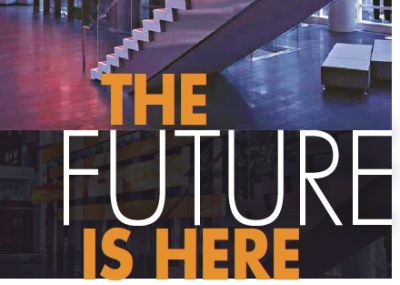THE FUTURE IS HERE - DIGITAL SIGNAGE HAS REACHED DS 3.0

We have been involved in this industry for almost 20 years. We started at a time when 40-inch plasmas cost as much as a small car, and 60-inch plasmas were just becoming available for the cost of a luxury car. Perhaps that explains why putting almost anything on those screens at that time could attract attention.
Twenty years later, electronic displays are affordable—and everywhere. Now, it is absolutely necessary to focus real thought and creativity into every aspect of a DS deployment, if you want it to be successful.
In the beginning, advertisers and corporate clients were able to build playlists of one video after another, all empty calories of dull advertising or propaganda. Try that approach today, and you are going to achieve what we lovingly refer to as “digital wallpaper.” I can’t tell you how happy I am that those days are almost over.
The Way Forward
As most of us know, DS is a completely new medium with its own complete set of rules, which have to be followed to achieve any level of success. In the world of DS 3.0, we understand that digital signage options should not be driven by the hardware choice, but rather by the intended communication goals. The display location, display technology, screen size, content strategy and especially the content management system, now all need to be driven by the communication objectives and the audience.
In the DS 3.0 world, architects are now integrating and showcasing display technology in the initial design process. We are getting fewer calls from clients who have just installed expensive display hardware only to realize that they need to put something useful on those screens. All creativity needs some constraints, but it is next to impossible to achieve positive results by creating good content for screens that are in the wrong location or using the wrong technology.
In the early days of digital signage, corporations realized that DS networks could communicate with workers who did not have access to computers and who rarely read printed corporate periodicals. That worked for a while, but employees quickly tired of a steady diet of corporate propaganda. Dull repetitive workplace content bore no resemblance to the dynamic content they could watch on their TVs at home. And they could change the channel at home.
In DS 3.0, corporate clients are creating dynamic and relevant content for their visitors and employees. The result is that the content is reaching an attentive audience and achieving its goals. But, what about office workers who have multiple screens on their desks? How do we create content that is current, captivating and relevant to them? DS 3.0 understands the true potential and leverages the technology to achieve multiple objectives for multiple audiences.
A daily selection of the top stories for AV integrators, resellers and consultants. Sign up below.
- Corporate branding for internal and external audiences
- Great architectural design: creating dynamic design elements that energize interior and exterior spaces
- Metrics/dashboards: displays that become the go-to spot for key information
- Employee communication: information and community building throughout an organization
- Here are a few tricks and tools to make this work:
- Don’t try to create all your content from scratch. There are so many great sources and resources for dynamic and relevant content.
- You don’t have to hire a whole department of graphic artists when you can build a self-service model in which existing employees throughout the organization can easily enter information into pre-baked dynamic graphic templates.
- Design screens with multiple elements of dynamic content so there is always something on screen to interest a viewer.
- Search out affordable new display technologies and find unique ways to leverage them to energize your environment.
- Add interactivity (in all its forms) so that users can actively participate in the communication process.
- Choose your content management system carefully. What the system promises is often very different from what it actually does.
One of our first clients who “got it” was Bloomberg LP. They have literally built their world headquarters in New York City around three very different and very powerful digital signage initiatives. We are especially pleased that Lisa Cohen from Bloomberg has agreed to speak at Digital Signage Expo 2013 with us. In our presentation we will be showing and discussing how Bloomberg saw the future and jumped straight into the world of DS 3.0.
James Fine is founder and president of Telecine Multimedia, a 25+ year-old Montréal-based company dedicated to great corporate communication. Fortune 500 clients from around the world rely on Telecine to solve their communication challenges by leveraging electronic media. Technology evolves and Telecine has evolved with it. Fine’s talent is in guiding his clients through the maze of options to find the best possible solution for them. His educational background in business and communications, and his passion for electronic toys... err... tools, prepares him well for this role. He enjoys sharing the lessons that he has learned over the years and firmly believes that “there are so many new mistakes to make, why make the same ones twice?”
